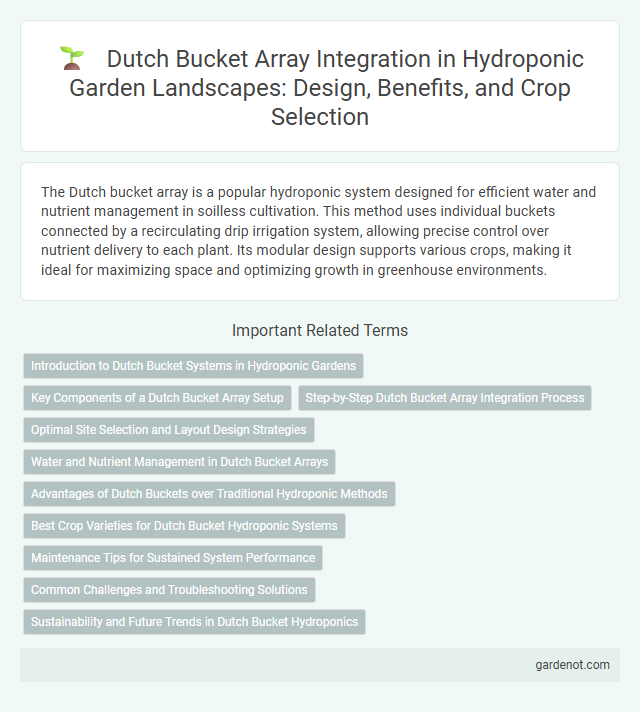The Dutch bucket array is a popular hydroponic system designed for efficient water and nutrient management in soilless cultivation. This method uses individual buckets connected by a recirculating drip irrigation system, allowing precise control over nutrient delivery to each plant. Its modular design supports various crops, making it ideal for maximizing space and optimizing growth in greenhouse environments.
Introduction to Dutch Bucket Systems in Hydroponic Gardens
Dutch bucket systems in hydroponic gardens use modular containers filled with inert media to support plant roots while delivering nutrient-rich water through a closed-loop irrigation system. This method optimizes water efficiency and nutrient uptake for crops like tomatoes, peppers, and cucumbers by precisely controlling pH and EC levels. The scalable design allows for easy expansion and maintenance, making Dutch buckets ideal for commercial and home hydroponic landscapes.
Key Components of a Dutch Bucket Array Setup
A Dutch bucket array setup includes key components such as individual buckets typically made of durable plastic, each equipped with a drainage hole and connected to a common drain line to ensure efficient water runoff. The system incorporates a nutrient reservoir with a submersible pump that circulates nutrient-rich water through drip emitters feeding each bucket, optimizing plant hydration and nutrient delivery. Additionally, support structures like trellises or frames provide stability for climbing crops, while filters and valves regulate water flow to maintain a balanced hydroponic environment.
Step-by-Step Dutch Bucket Array Integration Process
The Dutch bucket array integration process begins with selecting high-quality UV-resistant buckets arranged in a stable framework to maximize space efficiency and plant access. Next, a recirculating water and nutrient delivery system is installed with precise emitters delivering tailored nutrient solutions directly to each bucket's root zone. Finally, sensors monitor moisture levels and nutrient concentration, enabling automated adjustments to optimize hydroponic crop growth and yield within controlled environments.
Optimal Site Selection and Layout Design Strategies
Selecting an optimal site for a Dutch bucket array involves evaluating factors such as sunlight exposure, wind protection, and accessibility to water and electricity sources to ensure efficient plant growth and system maintenance. Proper layout design maximizes space utilization by arranging buckets in rows aligned with the sun's path, facilitating uniform light distribution and airflow. Integrating modular designs and adjustable spacing accommodates different crop types and growth stages, enhancing overall productivity and resource management.
Water and Nutrient Management in Dutch Bucket Arrays
Dutch bucket arrays optimize water and nutrient management by enabling precise delivery of hydroponic solutions directly to each plant's root zone, minimizing runoff and waste. The closed-loop system recirculates nutrient-rich water, maintaining consistent pH and EC levels that enhance nutrient uptake and plant growth. Automated drip emitters integrated within the buckets ensure uniform distribution, supporting efficient resource use and reducing labor costs.
Advantages of Dutch Buckets over Traditional Hydroponic Methods
Dutch bucket systems provide precise water and nutrient delivery directly to plant roots, minimizing waste and promoting efficient use of resources compared to traditional hydroponic methods. Their modular design supports a wide variety of plant species, allowing for scalable and flexible cultivation setups ideal for commercial production. Enhanced aeration within the buckets improves root health, leading to robust plant growth and higher yields.
Best Crop Varieties for Dutch Bucket Hydroponic Systems
Tomatoes, peppers, and cucumbers excel in Dutch bucket hydroponic systems due to their vine growth habits and high nutrient demands. Leafy greens like lettuce and spinach thrive when paired with optimized water and nutrient flow in these buckets. Strawberries also perform well, benefiting from precise moisture control and aeration unique to Dutch bucket setups.
Maintenance Tips for Sustained System Performance
Regular inspection of Dutch bucket arrays ensures early detection of clogs, leaks, and nutrient imbalances, preventing system failures. Cleaning pumps, drip emitters, and filters every two weeks maintains optimal water flow and nutrient delivery. Adjusting pH and electrical conductivity (EC) levels weekly supports consistent plant growth and maximizes yield in hydroponic landscapes.
Common Challenges and Troubleshooting Solutions
Dutch bucket arrays often face challenges such as nutrient imbalances, salt buildup, and inconsistent water flow, which can hinder plant growth and yield. Regular monitoring of EC levels, flushing the system to prevent salt accumulation, and ensuring proper bucket spacing and drainage are essential troubleshooting solutions. Implementing an automated fertigation system can help maintain nutrient consistency and optimize overall system performance.
Sustainability and Future Trends in Dutch Bucket Hydroponics
Dutch bucket systems optimize water usage by recirculating nutrient solutions, significantly reducing waste compared to traditional soil cultivation. Sustainable materials and energy-efficient pumps are increasingly integrated, enhancing the eco-friendliness of Dutch bucket hydroponics. Emerging trends include automated nutrient management and AI-driven monitoring, which improve crop yield and resource efficiency for future urban farming applications.
Dutch bucket array Infographic

 gardenot.com
gardenot.com